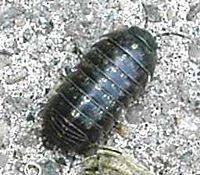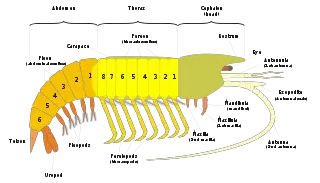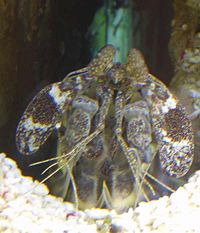Difference between revisions of "Malacostraca" - New World Encyclopedia
Rick Swarts (talk | contribs) |
Rick Swarts (talk | contribs) |
||
| Line 15: | Line 15: | ||
}} | }} | ||
| − | '''Malacostraca''' is a large and diverse [[taxon]] (generally class, but sometimes subclass or order) of marine, freshwater, and terrestrial [[crustacean]]s | + | '''Malacostraca''' is a large and diverse [[taxon]] (generally class, but sometimes subclass or order) of marine, freshwater, and terrestrial [[crustacean]]s, including many of the most familiar crustaceans, such as [[crab]]s, [[lobster]]s, [[shrimp]]s, which are characterized by a maximum of 19 pairs of appendages as well as trunk limbs that are sharply differentiated into a thoracic series and an abdominal series. Other familiar members of the Malacostraca are the stomatopods ([[mantis shrimp]]) and euphausiids ([[krill]]), as well as the [[amphipod]]s, and the only substantial group of land-based crustaceans, the [[isopod]]s ([[woodlouse|woodlice]] and related species). With more than 22,000 members, this group represents two thirds of all crustacean [[species]] and contains all the larger forms. |
| + | |||
| + | This is a very diverse group of | ||
==Overview and description== | ==Overview and description== | ||
| + | [[Image:General malacostracan en.svg|thumb|320px|left|General malacostracan ''[[Bauplan]]'']] | ||
| + | The taxonomic status of the crustaceans has long been debated, with [[Crustacea]] variously assigned to the rank of phylum, subphylum, and superclass level. As a result, the taxonomic status of Malacostraca is not settled, generally being considered a class within the subphylum or superclass Crustacea, but sometimes considered as an order or subclass under the class Crustacea. | ||
| − | ( | + | As crustaceans, members of Malacostraca are characterized by by having branched (biramous) appendages, an exoskeleton made up of [[chitin]] and [[calcium]], two pairs of antennae that extend in front of the mouth, and paired appendages that act like jaws, with three pairs of biting mouthparts. They share with other arthropods the possession of a segmented body, a pair of jointed appendages on each segment, and a hard exoskeleton that must be periodically shed for growth. |
| − | + | Members of Malacostraca are united by generally having a maximum of 19 pairs of appendages, and by having trunk limbs differentiated into an abdominal series and thoracic series, with the former having six pairs and the later eight pairs of limbs. Typical characteristics include: | |
| − | |||
| − | |||
| − | |||
| − | |||
| − | |||
| − | |||
*The head has 6 segments, with a pair of [[antennule]]s and a pair of [[antenna (biology)|antennae]], as well as [[mouthparts]]. | *The head has 6 segments, with a pair of [[antennule]]s and a pair of [[antenna (biology)|antennae]], as well as [[mouthparts]]. | ||
*They usually have 8 pairs of thoracic legs, of which the first pair or several pairs are often modified into feeding appendages called maxillipeds. The first pair of legs behind the maxillipeds is often modified into pincers. | *They usually have 8 pairs of thoracic legs, of which the first pair or several pairs are often modified into feeding appendages called maxillipeds. The first pair of legs behind the maxillipeds is often modified into pincers. | ||
| Line 35: | Line 33: | ||
*They have a two-chambered [[stomach]]. | *They have a two-chambered [[stomach]]. | ||
*They have a centralized [[nervous system]]. | *They have a centralized [[nervous system]]. | ||
| + | |||
| + | However, this is a very diverse group. Although the term Malacostraca comes from the Greek for "soft shell," the shell of different species may be large, small, or absent. Likewise, the abdomen may be long or sort, the eyes show different forms. | ||
| + | |||
| + | |||
==Classification== | ==Classification== | ||
| + | The first malacostracans appeared in the [[Cambrian]]. | ||
| + | |||
| + | The [[scientific classification|classification]] of crustaceans is currently being debated, and the Malacostraca are regarded by some authors as a [[class (biology)|class]] and by others as a [[Subclass (biology)|subclass]]. | ||
| + | |||
| + | The phylogeny of this group of organisms is debated <ref>Schram, F. R. (1986). Crustacea. Oxford University Press.</ref>. Recent molecular studies (18S <ref>Meland, K., & Willassen, E. (2007). The disunity of “Mysidacea” (Crustacea). Molecular Phylogenetics and Evolution , 44, 1083–1104.</ref>and 28S<ref>Jarman, S. N., Nicol, S., Elliott, N. G., & McMinn, A. (2000). 28S rDNA Evolution in the Eumalacostraca and the Phylogenetic Position of Krill. Molecular Phylogenetics and Evolution , 17(1), 26–36.</ref>) have even disputed the monophyly of the Peracarida by removing the Mysida and have firmly disproven the monophyly of the [[Edriophthalma]] ([[Isopoda]] and [[Amphipoda]]) and the [[Mysidacea]] ([[Mysida]], [[Lophogastrida]] and [[Pygocephalomorpha]]). | ||
| + | |||
| + | |||
Martin and Davis<ref>{{cite book|author = Joel W. Martin and George E. Davis|title = [http://www.nhm.org/research/publications/CrustaceaClassification.pdf An Updated Classification of the Recent Crustacea]|year = 2001|publisher = Natural History Museum of Los Angeles County}}</ref> present the following classification of living malacostracans into orders, to which extinct orders have been added, indicated by †. | Martin and Davis<ref>{{cite book|author = Joel W. Martin and George E. Davis|title = [http://www.nhm.org/research/publications/CrustaceaClassification.pdf An Updated Classification of the Recent Crustacea]|year = 2001|publisher = Natural History Museum of Los Angeles County}}</ref> present the following classification of living malacostracans into orders, to which extinct orders have been added, indicated by †. | ||
| Line 70: | Line 79: | ||
==References== | ==References== | ||
| − | + | * Hobbs, H. H. 2003. [http://www.routledge-ny.com/ref/caves/samples.html Crustacea]. In ''Encyclopedia of Caves and Karst Science''. Routledge. Retrieved December 5, 2006. | |
| − | + | ||
| − | + | * Martin, J. W., and G. E. Davis. 2001. [http://www.nhm.org/research/publications/CrustaceaClassification.pdf ''An Updated Classification of the Recent Crustacea''] Natural History Museum of Los Angeles County. | |
==External links== | ==External links== | ||
Revision as of 20:28, 9 November 2008
| Malacostraca | ||||||||
|---|---|---|---|---|---|---|---|---|
 | ||||||||
| Scientific classification | ||||||||
| ||||||||
|
Eumalacostraca |
Malacostraca is a large and diverse taxon (generally class, but sometimes subclass or order) of marine, freshwater, and terrestrial crustaceans, including many of the most familiar crustaceans, such as crabs, lobsters, shrimps, which are characterized by a maximum of 19 pairs of appendages as well as trunk limbs that are sharply differentiated into a thoracic series and an abdominal series. Other familiar members of the Malacostraca are the stomatopods (mantis shrimp) and euphausiids (krill), as well as the amphipods, and the only substantial group of land-based crustaceans, the isopods (woodlice and related species). With more than 22,000 members, this group represents two thirds of all crustacean species and contains all the larger forms.
This is a very diverse group of
Overview and description
The taxonomic status of the crustaceans has long been debated, with Crustacea variously assigned to the rank of phylum, subphylum, and superclass level. As a result, the taxonomic status of Malacostraca is not settled, generally being considered a class within the subphylum or superclass Crustacea, but sometimes considered as an order or subclass under the class Crustacea.
As crustaceans, members of Malacostraca are characterized by by having branched (biramous) appendages, an exoskeleton made up of chitin and calcium, two pairs of antennae that extend in front of the mouth, and paired appendages that act like jaws, with three pairs of biting mouthparts. They share with other arthropods the possession of a segmented body, a pair of jointed appendages on each segment, and a hard exoskeleton that must be periodically shed for growth.
Members of Malacostraca are united by generally having a maximum of 19 pairs of appendages, and by having trunk limbs differentiated into an abdominal series and thoracic series, with the former having six pairs and the later eight pairs of limbs. Typical characteristics include:
- The head has 6 segments, with a pair of antennules and a pair of antennae, as well as mouthparts.
- They usually have 8 pairs of thoracic legs, of which the first pair or several pairs are often modified into feeding appendages called maxillipeds. The first pair of legs behind the maxillipeds is often modified into pincers.
- There are 8 thoracic segments. The cephalothorax is covered by a carapace form via fusion of 3 of them, letting the 5 other uncovered.
- The abdomen is behind and often used for swimming. There are 6 abdominal segments.
- They have compound stalked or sessile eyes.
- They have a two-chambered stomach.
- They have a centralized nervous system.
However, this is a very diverse group. Although the term Malacostraca comes from the Greek for "soft shell," the shell of different species may be large, small, or absent. Likewise, the abdomen may be long or sort, the eyes show different forms.
Classification
The first malacostracans appeared in the Cambrian.
The classification of crustaceans is currently being debated, and the Malacostraca are regarded by some authors as a class and by others as a subclass.
The phylogeny of this group of organisms is debated [1]. Recent molecular studies (18S [2]and 28S[3]) have even disputed the monophyly of the Peracarida by removing the Mysida and have firmly disproven the monophyly of the Edriophthalma (Isopoda and Amphipoda) and the Mysidacea (Mysida, Lophogastrida and Pygocephalomorpha).
Martin and Davis[4] present the following classification of living malacostracans into orders, to which extinct orders have been added, indicated by †.

Class Malacostraca Latreille, 1802
- Subclass Phyllocarida Packard, 1879
- †Order Archaeostraca
- †Order Hoplostraca
- †Order Canadaspidida
- Order Leptostraca Claus, 1880
- Subclass Hoplocarida Calman, 1904
- Order Stomatopoda Latreille, 1817 (mantis shrimp)
- Subclass Eumalacostraca Grobben, 1892
- Superorder Syncarida Packard, 1885
- †Order Palaeocaridacea
- Order Bathynellacea Chappuis, 1915
- Order Anaspidacea Calman, 1904
- Superorder Peracarida Calman, 1904
- Order Spelaeogriphacea Gordon, 1957
- Order Thermosbaenacea Monod, 1927
- Order Lophogastrida Sars, 1870
- Order Mysida Haworth, 1825 (opossum shrimp)
- Order Mictacea Bowman, Garner, Hessler, Iliffe & Sanders, 1985
- Order Amphipoda Latreille, 1816
- Order Isopoda Latreille, 1817 (woodlice, slaters)
- Order Tanaidacea Dana, 1849
- Order Cumacea Krøyer, 1846 (hooded shrimp)
- Superorder Eucarida Calman, 1904
- Order Euphausiacea Dana, 1852 (krill)
- Order Amphionidacea Williamson, 1973
- Order Decapoda Latreille, 1802 (crabs, lobsters, shrimp)
- Superorder Syncarida Packard, 1885
ReferencesISBN links support NWE through referral fees
- Hobbs, H. H. 2003. Crustacea. In Encyclopedia of Caves and Karst Science. Routledge. Retrieved December 5, 2006.
- Martin, J. W., and G. E. Davis. 2001. An Updated Classification of the Recent Crustacea Natural History Museum of Los Angeles County.
External links
- Malacostraca image key - Guide to the marine zooplankton of south eastern Australia, Tasmanian Aquaculture and Fisheries Institute
| |||||||||||||||||
Credits
New World Encyclopedia writers and editors rewrote and completed the Wikipedia article in accordance with New World Encyclopedia standards. This article abides by terms of the Creative Commons CC-by-sa 3.0 License (CC-by-sa), which may be used and disseminated with proper attribution. Credit is due under the terms of this license that can reference both the New World Encyclopedia contributors and the selfless volunteer contributors of the Wikimedia Foundation. To cite this article click here for a list of acceptable citing formats.The history of earlier contributions by wikipedians is accessible to researchers here:
The history of this article since it was imported to New World Encyclopedia:
Note: Some restrictions may apply to use of individual images which are separately licensed.
- ↑ Schram, F. R. (1986). Crustacea. Oxford University Press.
- ↑ Meland, K., & Willassen, E. (2007). The disunity of “Mysidacea” (Crustacea). Molecular Phylogenetics and Evolution , 44, 1083–1104.
- ↑ Jarman, S. N., Nicol, S., Elliott, N. G., & McMinn, A. (2000). 28S rDNA Evolution in the Eumalacostraca and the Phylogenetic Position of Krill. Molecular Phylogenetics and Evolution , 17(1), 26–36.
- ↑ Joel W. Martin and George E. Davis (2001). An Updated Classification of the Recent Crustacea. Natural History Museum of Los Angeles County.

